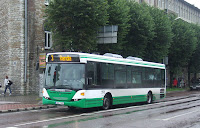Both Finland and Estonia had been part of the Russian empire until the early 20th Century. Finland declared independence in 1917, Estonia a year later. However, while Finland remained independent, developing during post-war years as a western economy, Estonia had been annexed by the Soviet Union during the Second World War. Estonia regained independence in 1991 as the USSR collapsed.
Tallinn is another city with an Olympic connection. Host city for the 1980 Olympic Games was Moscow, but the sailing events were held in Tallinn.
The public transport network in Tallinn is co-ordinated by the city goverment. The mediaeval old town, a designated UNESCO World Heritage Site, is more-or-less pedestrianised. On the streets outside the old city walls, you will find buses, trolleybuses and trams. Journeys into the centre of Tallinn are generally direct, rather than by feeder services to interchanges. Information about the public transport network is on the Tallinn website.
 When I visited Tallinn in 2008, the buses I found were invariably from Scandinavian manufacturers. Those used on city services wore a green-based livery.
When I visited Tallinn in 2008, the buses I found were invariably from Scandinavian manufacturers. Those used on city services wore a green-based livery.

As well as standard single-deckers, there are plenty of articulated vehicles


 Longer-distance bus services, which are not part of the Tallinn city transport system, carry other colour schemes such as this articulated vehicle.
Longer-distance bus services, which are not part of the Tallinn city transport system, carry other colour schemes such as this articulated vehicle.As in many cities I have visited, double-deck buses were used only on sightseeing tours.
Trolleybuses were introduced to Tallinn in 1965, at a time when many western cities were abandoning electric systems in favour of diesel-powered buses. The trolleybus network operates into the centre of Tallinn from the west and south west of the city. At the time I visited, many of the trolleybuses were of Eastern European manufacture. The fleet comprised both standard and articulated vehicles in a blue and white livery.





Some newer trolleybuses were also operating

The tram network comprises four routes operating across the city centre. At the time of my visit, the entire tram fleet dated from the Communist era. Most carried a blue-based colour scheme.


A small number of trams were operating in a red and white colour scheme. These had been acquired second-hand from the German city of Gera.
There were also trams carrying advertising liveries. In the city centre, trams operate along the streets. Outside the centre, some parts of the network are on separate reserved track.

A common arrangement in Eastern European cities is for trams to stop in the middle of the street. Other traffic is prohibited from passing while passengers board and alight.

Low-floor access has been introduced by adding centre sections to some of the trams.



In a bold move by the city council to reduce car use, residents of Tallinn will be able to use the public transport network free of charge from 1st January 2013. Visitors to Tallinn will still be required to buy tickets to use the transport system, although the Tallinn Card permits unlimited use on Tallinn's bus, trolleybus and tram services.

































